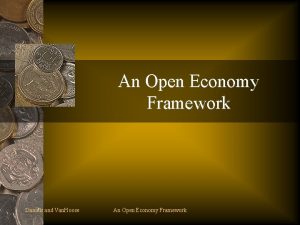Policy Coordination Daniels and Van Hoose Policy Coordination









- Slides: 9

Policy Coordination Daniels and Van. Hoose Policy Coordination

Structural Interdependence • Structural interdependence is the reason that policymakers might consider the joint determination of economic policies. • Structural interdependence refers to the interconnectedness of nations’ markets for goods and services, financial markets and payments systems. Daniels and Van. Hoose Policy Coordination 2

International Policy Externalities • Structural interdependences can results in international policy externalities: a benefit or cost for one nation’s economy owing to a policy undertaken in another economy. • A locomotive effect occurs when an increase in real income in one economy spurs an increase in real income in another. • A beggar-thy-neighbor effect occurs when a policy action benefits the residents of the home country at the expense of residents in another nation. Daniels and Van. Hoose Policy Coordination 3

International Policy Cooperation and Coordination • There are two ways that nations may work together to achieve their economic objectives. • International Policy Cooperation is the adoption of institutions and procedures by which policymakers can inform each other of their objectives and share data. • International Policy Coordination is the joint determination of economic policies within a group of nations, intended to benefit the whole. Daniels and Van. Hoose Policy Coordination 4

Potential Benefits of Coordination • • • Take account of and minimize policy externalities Achieve a larger number of policy objectives with available instruments Policymakers may present a “united front” in the face of home political pressures that could push them to adopt harmful policies. Daniels and Van. Hoose Policy Coordination 5

Potential Drawbacks to Policy Coordination • • • Must sacrifice or forego some domestic interests Must trust that counterparts are willing to make sacrifices Coordinated policies may have negative consequences such as higher inflation (e. g. , Bonn Summit of 1978) Daniels and Van. Hoose Policy Coordination 6

Monetary Unions • An extreme type of coordination is for a nation to give up its own currency and adopt a currency common to it and a coalition of other nations. • That is, form a monetary union. • For a monetary union to succeed, the coalition must represent an optimal currency area. Daniels and Van. Hoose Policy Coordination 7

Optimal Currency Area • The theory of optimal currency areas is a means of determining the size of a geographic area within which residents’ welfare is greater if their governments fix exchange rates or adopt a common currency. • An optimal currency area is on in which labor is sufficiently mobile to permit speedy adjustments to payments imbalances and regional unemployment so that exchange rates can be fixed or a common currency adopted. Daniels and Van. Hoose Policy Coordination 8

Exchange Rate Target Zones • A target zone is a “intermediate” approach to exchange rate management that limits exchange rate volatility while still permitting some variation in countries currency values. • Specifically, a target zone is a range of permitted exchange rate variation between upper and lower exchange rate bands that a central bank defends by purchasing or selling foreign exchange reserves. Daniels and Van. Hoose Policy Coordination 9
















